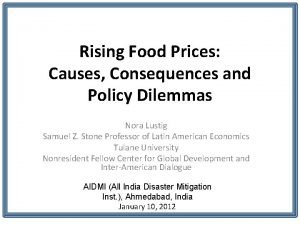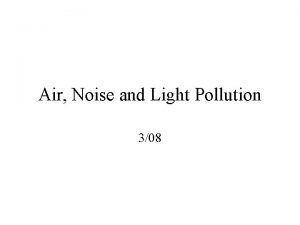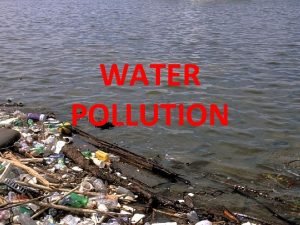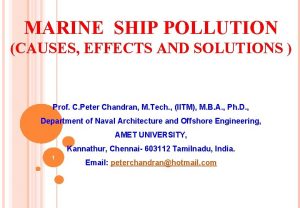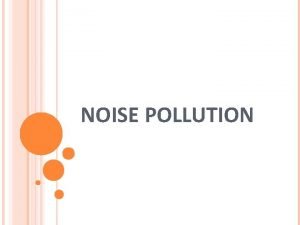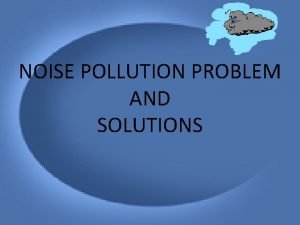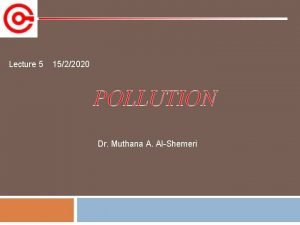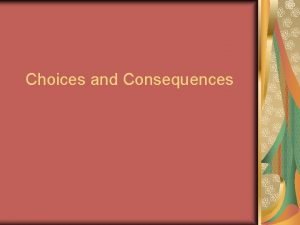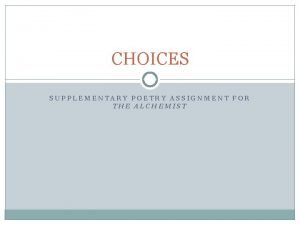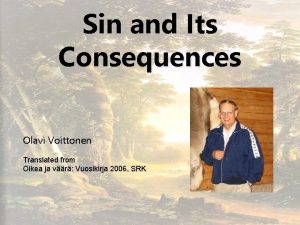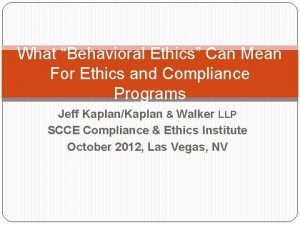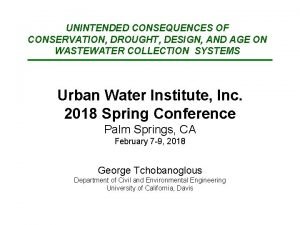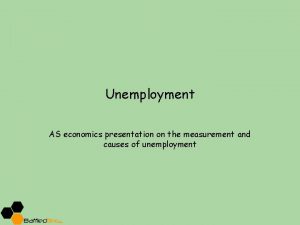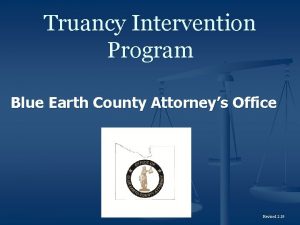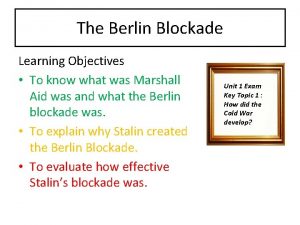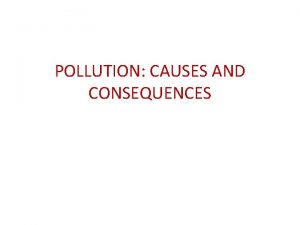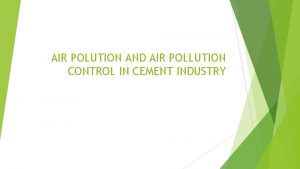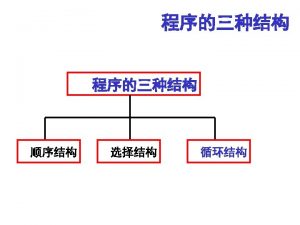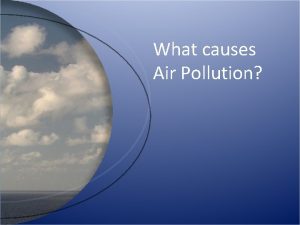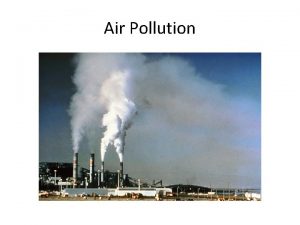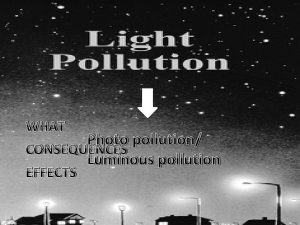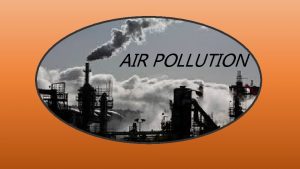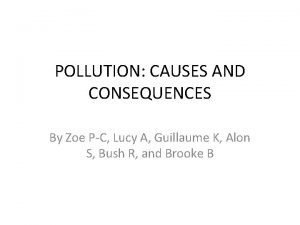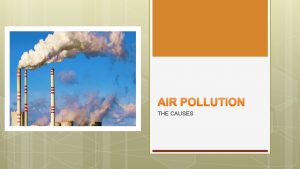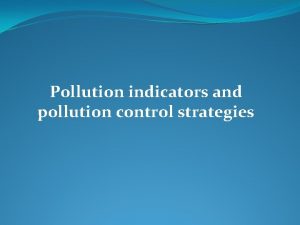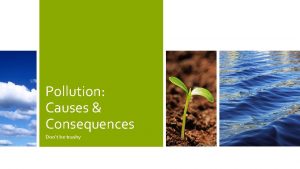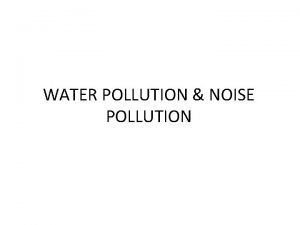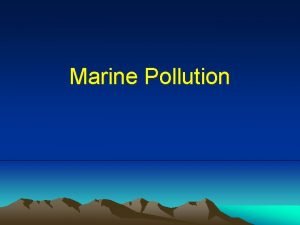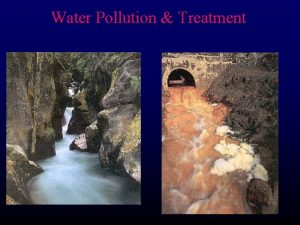POLLUTION CAUSES AND CONSEQUENCES Polution is a result






























- Slides: 30

POLLUTION: CAUSES AND CONSEQUENCES

Polution is a result of • Better technology- leading to industrialization • Advances in medicine leading to population increase • Huge population increase leads to – Increased use of chemicals – Increased use of transportation vehicles that emit pollutants – Increased use of goods and products that are not biodegradable

Environmental Impacts • Pollution – increase in cars and emission of greenhouse gases into atmosphere • Deforestation – increase in paved areas to house increasing population • Freshwater Availability – increase in waste production and contamination of water • Natural Resources – increase burning of fossil fuels, excessive use of coal • Global Warming – overall increase in temperature and chances of natural disasters • Habitat Loss – change in ecosystems affecting trophic levels

What is pollution? • Pollution is the introduction of harmful substances or products into the environment • We will be examining 3 main parts of pollution – Water Pollution – Air Pollution – Land Pollution

Water Pollution

Causes of Water Pollution • Factors that contribute to water pollution can be categorized into two different groups – Point sources – Non-point sources • Point sources are the easiest to identify and control • Non point sources are ambiguously defined and harder to control

Point Sources • Some point sources of water pollution include – Waste products from factories – Waste from sewage system – Waste from power plants – Waste from underground coalmines – Waste from oil wells • They are called point sources because they are direct sources of water pollution and can be reduced and monitored

Example of a point source

Non-point Sources • The term non-point source encompasses a large range of sources such as: – when rain or snow moves through the ground and picks up pollutants as it moves towards a major body of water – the runoff of fertilizers from farm animals and crop land – air pollutants getting washed or deposited to earth – storm water drainage from lawns, parking lots, and streets

Non-point source: Agricultural runoff

Air Pollution

Causes of Air Pollution • One of the main causes of air pollution is the release of carbon dioxide into the atmosphere, this happens because of Deforestation and fossil fuel burning • Sulfur dioxide is another air polluter and is released into the atmosphere by the burning of sulfur containing compounds of fossil fuels. Sulfur oxides are very dangerous to humans at a high concentration. Sulfur in the atmosphere is responsible for acid rain

More causes of air pollution: CFCs • Chlorofluorocarbons (CFCs) also contribute to air pollution by reducing the amount of ozone the stratosphere. CFCs come from a variety of places such as: – the burning of plastic foam items – leaking refrigerator equipment – spray cans

Natural Air Pollutants • Natural air pollutants can include: – Smoke from wild fires – Methane released from live stock – Volcanic eruptions

Consequences of Air Pollution • CO 2 is a good transmitter of sunlight, but it also partially restricts infrared radiation going back from the earth into space, which produces the socalled greenhouse effect that prevents a drastic cooling of the Earth during the night • Increasing the amount of CO 2 in the atmosphere reinforces this effect and is expected to result in a warming of the Earth's surface • CO 2 in atmosphere GLOBAL WARMING

The Greenhouse Effect

Acid Rain • When emissions of sulfur dioxide and nitric oxide from stationary sources are transported long distances by winds, they form secondary pollutants such as nitrogen dioxide, nitric acid vapor, and droplets containing solutions of sulfuric acid, sulfate, and nitrate salts • These chemicals descend to the earth's surface in wet form as rain or snow and in dry form as a gases fog, dew, or solid particles, it is known as acid rain or acid deposition

Acid Rain: Its effect on a tree

Smog • With the introduction of petroleum to replace coal economies in countries, photochemical smog has become predominant in many cities, which are located in sunny, warm, and dry climates with many motor vehicles • Worst episodes of photochemical smog tends to occur in summer

A smoggy city

Consequences continued • Sulfur dioxide, nitrogen oxides, ozone and peroxyacl nitrates (PANs), cause direct damage to leaves of crop plants and trees when they enter leaf pores (stomates) • Chronic exposure of leaves and needles to air pollutants can also break down the waxy coating that helps prevent excessive water loss and damage from diseases, pests, drought and frost

Consequences continued • "In the midwestern United States crop losses of wheat, corn, soybeans, and peanuts from damage by ozone and acid deposition amount to about $5 billion a year". (Miller 498)

Land Pollution

Causes of Land Pollution • Four Main causes of land pollution – Construction – Agriculture – Domestic waste – Industrial Waste

Construction • Buildings take up resources and land, the trees are chopped down and used to make buildings • Takes away from places for animals and other organisms to live

Agriculture • As there are more and more people inhabiting the earth, food is in higher demand so forests are chopped down and turned into farmland • In addition, herbicides, pesticides, artificial fertilizers, animal manure (poop) are washed into the soil and pollute it

Domestic Waste • Tons of domestic waste is dumped every day. Some waste from homes, offices and industries can be recycled or burnt in incinerators • There is still a lot of garbage, such as refrigerators and washing machines that are dumped in landfills simply because they cannot be reused in anyway, nor recycled

Industrial Waste • Plastics factories, chemical plants, oil refineries, nuclear waste disposal activity, large animal farms, coal-fired power plants, metals production factories and other heavy industry all contribute to land pollution

Consequences of Land Pollution Land pollution exterminates wild life Acid rain kills trees and other plants The vegetation that provides food and shelter is destroyed Land pollution can seriously disrupt the balance of nature, and, in extreme cases, can cause human fatalities • Pesticides can damage crops; kill vegetation; and poison birds, animals, and fish. Most pesticides kill or damage life forms other than those intended. For example, pesticides used in an effort to control or destroy undesirable vegetation and insects often destroy birds and small animals. Some life forms develop immunity to pesticides used to destroy them • •

WAYS TO STOP POLLUTION • You can help to reduce global air pollution and climate change by: – – – – Driving a car that gets at least 35 mpg Walking, biking, and using public transportation Using CFL bulbs over incandescent bulbs Buying only energy efficient appliances Recycling newspaper, aluminum, and others Planting trees! Avoid purchasing products that contain CFCs Supporting much stricter clean air laws and enforcement of international treaties to reduce ozone depletion and slow global warming
 Consequences of land pollution
Consequences of land pollution Rising food prices causes and consequences
Rising food prices causes and consequences Controlling measures of noise pollution
Controlling measures of noise pollution Air pollution consequences
Air pollution consequences Result and conclusion of water pollution
Result and conclusion of water pollution Pollution causes effects and solutions
Pollution causes effects and solutions Pollution causes effects and solutions
Pollution causes effects and solutions Solutions of noise pollution
Solutions of noise pollution Noise pollution problems
Noise pollution problems Chapter 12 section 1
Chapter 12 section 1 Effect on human health of land pollution
Effect on human health of land pollution Causes of noise pollution
Causes of noise pollution Chapter 12 air section 1 what causes air pollution
Chapter 12 air section 1 what causes air pollution Proximate causes of behavior
Proximate causes of behavior Polygyny in animals
Polygyny in animals Okonkwo's violent acts and consequences
Okonkwo's violent acts and consequences Objective consequences
Objective consequences Nikki giovanni choices
Nikki giovanni choices Olavi voittonen
Olavi voittonen 5 hazardous attitudes
5 hazardous attitudes What is the relationship between choices and consequences
What is the relationship between choices and consequences Motivated blindness
Motivated blindness How does juliet regain her parents' favor
How does juliet regain her parents' favor Actions and their consequences examples
Actions and their consequences examples Feedback rewards
Feedback rewards Unintended consequences
Unintended consequences Unemployment measures
Unemployment measures Blue earth county attorney
Blue earth county attorney Consequences of underage drinking
Consequences of underage drinking Berlin blockade summary
Berlin blockade summary Consequences of sin according to genesis
Consequences of sin according to genesis

